The redesigned 2013 Sentra is a bigger car, objectively a much nicer car – and without question a much more fuel efficient car – than the previous Sentra.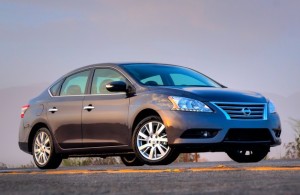
But is it a more appealing car than the smaller and less fuel efficient – but more powerful and sportier driving – car it replaces?
That is the question.
And the answer depends on what you’re looking for.
WHAT IT IS
The Sentra has traditionally been a sporty compact sedan – and thus, a distinct alternative to economy-minded compact sedans like the Toyota Corolla and Honda Civic.
But rising fuel prices – and rising government fuel-efficiency mandates – have put pressure on all automakers to put gas mileage uber alles.
Thus, the bigger-for-’13 Sentra comes with a smaller engine – and less horsepower – but also with a 40 MPG (highway) rating. That’s something the previous Sentra never came close to delivering – unless its engine wasn’t running.
But there’s no performance minded SE-R package – at the time of this review, at least – while there is an FE+ fuel economy package that includes low rolling resistance tires and aerodynamic aids to squeeze as many MPGs (rather than HPs) as possible out of a gallon of ethanol-adulterated “gas.”
Prices start at $15,990 for the base S model with six-speed manual transmission.
A range-topping SL with continuously variable (CVT) automatic transmission starts at $19,820.
The max-effort 40 MPG Sentra FE+ (also with CVT) starts at $17,770.
All Sentras are FWD.
Big enough on the inside to be a family car – if your family isn’t the Duggar family.
Nice enough to not be just another economy car.
A-plus fuel economy – with the CVT transmission.
2013 model starts out $440 lower than 2012 model.
WHAT’S NOT SO GOOD
No longer a sporty car.
C- acceleration with the CVT transmission.
B+ gas mileage with the limited-availability manual transmission.
UNDER THE HOOD
The ’13 Sentra is upsized – but there’s a downsized engine under the hood: 1.8 liters (and 130 hp) vs. 2.0 liters (and 140 hp) previously. This is the same basic engine that’s used in the smaller – and lighter – Versa.
A six-speed manual transmission is standard – but only in base S trim Sentras. All other trims come only with a continuously variable (CVT) automatic, which can be ordered as an a la carte extra for $1,330 with the base S trim.
Even though the new larger model weighs slightly less than the previous model (2,822 lbs. vs. 2,906 last year) the loss of engine displacement – and hp – is evident when the accelerator pedal is depressed: Zero to 60 now takes 9.7 seconds. That’s about half-a-second slower than the old Sentra.
In the car’s defense, several other cars in this segment – among them, the new Dodge Dart and also the Mazda3 – are equally lethargic. However, these two offer engine upgrades that cut the zero to 60 time down into the mid-low 8s – and in the case of the Mazda3, while still delivering exceptionally high gas mileage. The Sentra – so far – comes only with the overtasked 1.8 liter engine – too little engine for too much car.
You’re also virtually forced to buy the CVT automatic, too – at least, if you want something more than a base S trim Sentra – or some of the options that aren’t available in base S trim Sentras, such as the Driver’s package, which adds rear disc brakes (base S trims have drum rear brakes) or the upgrade 17 inch wheel package. These are available only in step-up SV and SR Sentras – and the top-of-the-line SL – which come only with the CVT.
For sport-minded buyers, that’s bad news.
For economy-minded buyers, the good news is the Sentra’s 30 city, 39 highway MPG rating (40 MPG, if you order the FE+ enhancements). This is a dramatic improvement over the 2012 Sentra, which topped out at 27 city, 34 highway. It’s also better by about 4-5 MPG than other economy-minded compact sedans such as the Honda Civic (28 city, 36 highway) as well as the current Toyota Corolla (27 city, 34 highway), Ford Focus (26 city, 36 highway) and Hyundai Elantra (28 city, 38 highway).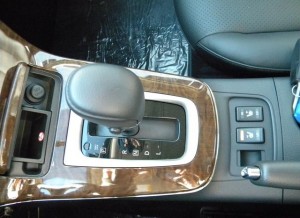
The Chevy Cruze, Dodge Dart and Mazda3 can do better – as much as 42 MPG highway, in the case of the Cruze and 41 MPG in the case of the Dodge Dart. But not with their standard engines – and not at a Sentra-equivalent price. To get the 42 MPG Cruze, for example, you’ve got to buy the optional 1.4 liter turbo engine. So equipped, the Cruze’s MSRP is $19,680 – or $2,360 more than the 39 MPG-capable (CVT equipped) $17,320 Sentra S and $1,910 more than the 40 MPG-capable $17,720 Sentra FE+ with CVT.
Same story with the Mazda3. The standard model only manages 33 highway. To get to 40 MPG, you’ve got to buy the optional SkyActive-G engine, which bumps the Mazda’s MSRP to $18,700 – $1,380 higher than the CVT-equipped (and 39 MPG) Sentra S.
And the base ($15,990) Sentra S with six-speed manual still manages 27 city, 36 highway. That’s right there with the figures posted by the Civic, Corolla, Focus and Elantra, slightly better than the base model Dodge Dart (25 city, 36 highway) and a lot better than the base model Mazda3.
Can’t knock that.
Well, here’s something you can.
I tested an early production Sentra SL with the CVT automatic transmission – which as mentioned earlier is now the only way you can get an SL or any other 2013 Sentra trim except the base S trim. The CVT is there – and a manual transmission isn’t – in four out of the five available Sentra trims because of the CVT’s efficiency advantage. It’s worth 3-4 MPG at highway speeds, relative to the manual six-speed Sentra – and that’s a big deal not just to potential buyers but also to Uncle, who insists that all new cars average 35.5 MPG by 2016. This pressure accounts for the increasing use of CVTs in numerous cars – and not just Nissans.
The problem is the down-powered, de-engined Sentra is slow – and the CVT transmission only makes it feel slower.
You can’t raise the RPMs and sidestep the clutch – because there is no clutch. And because there’s no torque converter – as in a conventional automatic – the same thing.
It takes longer for an engine mated to a CVT to get into its powerband.
And if the engine is a small engine, the powerband is probably fairly high up in the RPM range – as is the case here. The 1.8 liter’s peak power (130 hp) isn’t produced until 6,000 RPM – vs. 5,100 RPM (and 140 hp) last year. It doesn’t help matters that torque output is also down by 19 lbs.-ft (128 lbs.-ft now vs. 147 lbs.-ft. with the old 2.0 liter engine). The torque peak is more accessible now – 3,600 RPM now vs. 4,800 RPM before. But the bottom line is there’s less power available – and it shows. 
Especially with the CVT.
Even though Nissan has done an admirable job in terms of rendering the bigger (longer, more wheelbase, etc.) 2013 Sentra lighter at the curb than the smaller 2012 Sentra, it still weighs a pretty startling (for a compact) 2,822 lbs. – and that’s before the driver gets in. One 180 pound driver and the car is already over 3,000 lbs. Put two passengers in there on top of that and the Sentra’s curb weight will be 3,200 lbs.-plus.
It’s asking a lot of a 1.8 liter engine to get that much mass moving without obvious signs of struggling – and the CVT only serves to call attention to the power deficit by holding the poor little engine at its 6,000 RPM power peak – close to redline – as long as you keep your foot down.
Yes, it’ll get you from A to B – if you’re not in much of a hurry. But forget about passing C. You’ll just have to be patient and wait behind him. Just as others will need to be patient when they’re behind you while you’re trying to get up to speed … or while you’re waiting for room (and time) to risk pulling into traffic.
The Sentra’s CVT does have a Sport (as well as an Eco) setting – but I’d rather have a clutch and the ability to launch a little quicker and cull the drivetrain racket once rolling – even if it cost me three or four MPGs.
I understand why Nissan is hard-selling the CVT. But it wouldn’t be necessary if the Sentra didn’t weigh so much. A 2,500 lb. Sentra could probably hit 40 MPG without the CVT. And with the old 2.0 liter, 140 engine and six-speed manual transmission.
Then it would be fuel-efficient – and still fun.
This one’s not. Acceleration-wise as well as handling-wise.
The new Sentra is a Transportation Unit – like the Corolla and Civic. That’s apparently the target competition now – not sporty new comers like the Dodge Dart and Mazda3 – which appear to be taking over the slot the Sentra used to occupy. And from a business point-of-view, that probably makes sense – because Transportation Units are the volume sellers.
It’s where the money is.
The ’13 Sentra edges ever-closer to being a mid-sized car – especially as regards backseat legroom (more on this in a minute).
Nissan probably decided to build a bigger Sentra for two important reasons: To make up for the Sentra’s loss of performance – and to put more distance between the Sentra and its value-priced sibling, the Versa.
The ’12 model Sentra’s interior specifications were virtually the same as the Versa’s (in one area at least – backseat legroom – the Versa had more room than the Sentra). Buyers were probably more willing to overlook the previous Sentra’s slightly cramped interior when the Sentra had more engine and more personality. But now that the Sentra has the same downsized 1.8 liter engine as the Versa?
Time to upsize something else!
Thus, the new car is about two and a half inches longer than the old model and rides on a longer 106.3 inch wheelbase vs. 105.7 inches previously. This makes it look more substantial – and allows for a substantially roomier backseat area: three inches more legroom than before (37.4 inches ) as well as a mid-sized car’s trunk: 15.1 cubic feet vs. 13.1 cubic feet last year. 
Also bigger are the front doors.
Actually, they’re huge relative to the rest of the car – and relative to other cars. I got out my tape measure – 44 inches from edge to edge. For a “compact” car, that’s a big door. Some perspective: I happened to have a 2013 Buick Verano sedan the same week I had the Sentra. The Verano – Buick’s entry-luxury sedan – is a bigger car than Sentra – 183.9 inches end to end vs. 182.1 inches for the Nissan. But the Buick’s front doors were three full inches shorter than the new Sentra’s.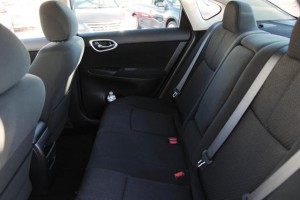
Of course, a big door can be used to create the illusion of space. One that’s sometimes dispelled when you actually sit inside the car. That’s not the case here, though. The new Sentra’s got slightly more front seat legroom than the bigger-on-the-outside Buick (42.5 inches vs. 42 inches) and more backseat legroom than its big (and mid-sized) brother, the Altima (36.1 inches). But what’s really important is that the ’13 Sentra’s got three inches more backseat legroom than the old Sentra (34.5 inches) and about a half-inch more rearseat legroom than you’d get in the value-priced Versa sedan (37 inches).
The ’13 Sentra’s interior, like the rest of the car, is also more lux – and less sport.
The old car’s high-mounted shifter console is gone. In its place, a conventional center console and floor-mounted shifter – available with wood trim covers rather than carbon fiber or brushed metal. Also gone are the previous Sentra’s optional accessory gauges – which had been mounted, 370Z-like, on top of the dash and canted toward the driver. 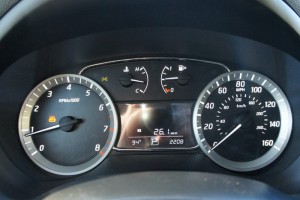
The 5.8 inch LCD screen for the GPS is bigger, too.
An amusing touch is the new car’s 160 MPH speedometer – vs. 140 MPH in the old model.
JATO rockets not included.
THE REST
It’s pretty obvious the trend toward smaller, less powerful – and more economical – engines is upon us. Nissan’s just bowing to the inevitable – and trying to make the best of it. In most respects, the new Sentra is a better car than the model it replaces. But it’s also a blander car – and it remains to be seen whether Nissan buyers will be happy about the changeover.
All that’s missing, really, is an underhood upgrade – which may or may not be forthcoming. Probably, not. The market’s just not there anymore.
Meanwhile, the government is.
Throw it in the Woods?



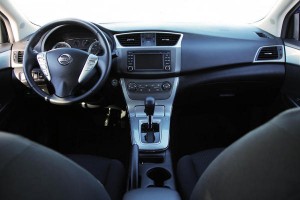


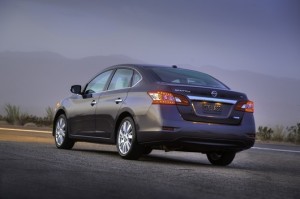







That seems awfully short for a clutch even for a performance car. It sounds like most clutch owners are riding or slipping the clutch a lot.
The last Subaru I owned (2000 Outback) got around 120k on the first clutch and I lived in a very hilly area and did a lot of city stop and go driving.
All modern cars with manual transmissions have self-adjusting (and hydraulic assist) clutches – which has increased service life considerably. I’ve got a ’98 Nissan truck with 148k on it and the original clutch!
Reg; “elf-adjusting (and hydraulic assist) clutches – which has increased service life”
Good point, but apparently moot in the face of typical reality. And, your a good driver, Eric. You understand the mechanical limitations and good/intended operational procedure.
100,000 plus miles for a a very good operator in the flat lands and rural areas. 35,000 to 65,000 miles is more typical. Gene(Subaru service manager) says, that the average for Subaru owners, is around 35,000-45,000 miles.
My 93′ Miata has 166,— miles on the original clutch, it is at its reasonable limits, yet still functional, and I have no fear it will leave me on the side of the road anytime soon.
The reassuring advantage of manual transmissions/clutches, is, you are aware of their condition.
Servicing CVT’s depends on the type, but service intervals are usually quite long, depending on use, and range from 60,000 to 150,000 miles.
@ Tom,
CVT’s are put into cars for their efficient use of available torque.
They are quite reliable and cheaper to fix then almost any type of transmission. The early failure of the Nissan Murano CVT has created this idea that they aren’t reliable, not true. We have too remember, that Subaru successfully used the CVT in the Justys.
What plagues the CVT is driving feel.
My fist experience with CVT’s was with my Formula ‘440’s and ‘500’s. I built a team of three cars and except for the occasional belt change for wear, not failure, they performed flawlessly. The belts wouldn’t have needed changing, except that when your running at the championship level, you need every advantage.
We ran these cars in SCCA, Mini Indy, and club events. Still a fun track day car for not much outgo>$$$ or up keep. Tires last a season for track days. In Formula Ford a Hewland transaxle would cost me $5,000 over a season for one car. More if we were competing at the national level.
http://www.autoguide.com/auto-news/2012/05/should-you-buy-a-car-with-a-cvt-transmission.html
http://www.google.com/search?q=formula+440&hl=en&client=firefox-a&tbo=u&rls=org.mozilla:en-US:official&channel=np&tbm=isch&source=univ&sa=X&ei=zDPlUMTDI6bhiAKOr4GABA&sqi=2&ved=0CDIQsAQ&biw=1390&bih=709
http://en.wikipedia.org/wiki/Formula_500
But the Justy didn’t exactly have a stellar reputation on the transmission. In fact the CVT was one of the weakest things on that particular series of vehicle and remember the Justy only had a small 3 Cylinder engine, hardly a powerhouse.
As a mechanical engineer I understand the WHY of a CVT when it comes to power efficiency. However when I purchase a vehicle, long term reliability is also a huge factor.
I know that for example the Jeep Compass has some serious issues with the CVT it had for at least the first year.
Given that CVT’s are not a proven technology I’m just a bit surprised to not see the 6-8 speed automatics more frequently. Of course at a this level of vehicle price is also a huge consideration.
I know Nissan and others have upped the ante with very long warranties, but like I said, given that I hold onto a car for 12-20 years typically, why would I risk a CVT and a potentially expensive repair down the road?
The Justy eCVT issues were mostly Electronic, and then lack of maintenance as they aged with multiply owners.
A friend of mine who bought one new and still drives it, daily, and who has been the Service manager for a local Portland area Subaru dealer for the past 30 years, would take issue with your anecdotal claim of the unreliability of the Justy eCVT or any other Subaru CVT.
CVT’s are not usually repaired by Independent transmission shops. It is, usually, a Dealer maintained situation.
‘Proven technology’…? CVT’s, in their various types, have been ‘reliably’ around for some 80+ years. I wish that light trucks employed them. It would make towing a lot easier.
If any car companies are reading this, here’s what it will take to sell me an electric car: Charged range of 250 miles – real miles, with lights shining, AC blowing and radio playing, not some lab figure that’s too optimistic by 50 percent. An ROI of no more than 2 years greater than a comparable non-electric car. All-wheel drive – I live in freakin’ New England, where we have snow. Make it the size (at least) of something like a Subaru wagon so I can carry all my guns. Batteries should be replaceable by a shade-tree mechanic (Tom Swift and His Electric Car, anyone?)
That would sell me on an electric car. Until then… keep trying.
Thanks for your input on the CVT issue, TRe.
I agree, the chief issue is feel rather than functionality. And in my experience (having driven pretty much every make/model of CVT-equipped car built recently) it’s less the fault of the CVT than it is the fault of the car company for putting an over-taxed engine in a too-heavy car. When a CVT is paired with an engine that has enough power to move the car without requiring virtually every available hp, the driving experience is typically pleasant. In fact, more pleasant than with a conventional (hydraulic) automatic, because of the absence of shift shock and so on.
Hi! Eric,
‘Over taxed engines’ will be the norm in the near future as manufacturers strive for better EPA ratings.
Yes, reduced torque impact(s) are one of the benefits of CVT’s, resulting in longer life for engines and other drive train components, including, often forgotten, drive tires.
I guess my biggest concern with purchasing a CVT is finding one that has a reliable track record. Being that I’ve been burned by a bad transmission before I’ve become acutely aware of the repair cost and would prefer not to repeat the experience.
The other issue is it’s getting harder and harder to find a manual transmission on new cars.
Tom,
Your concerns about ‘Reliability’ could also be applied to both manual transmissions and conventional automatics.
Clutch repairs over the life of a vehicle in the hands of the average operator, are considerable. Conventional automatics also have very short lifespans, but that is improving while also escalating in cost, exponentially.
A typical clutch these days does last over 100k miles or more (given that you don’t ride the clutch or abuse it) and the typical repair cost is about $850-900 for a new clutch so I don’t disagree. With a clutch however, I know what I’m getting into and I can’t say the same for a CVT.
Conventional automatics are sort of hit and miss. You can have ones like the 99′-04′ Honda Odyssey which had horrible failure rates or you can have ones like the mid to late 90’s Corolla which last 250k+ on average.
All this talk of CVT’s has got me a bit curious on the regular maintenance required for one. For a traditional automatic the typical was a normal fluid change every 25-35k under normal conditions and a complete fluid change-out every 75-100k. That meant unless you did it yourself you were spending $100 every 2-3 years and about $170 every 5-8 years.
I have to wonder why all the CVT’s and not more multi-speed automatics. I’m not hearing good things about any of the CVT’s from my transmission guy. When I recently went new/used car shopping one of the things I was told to stay away from by both the transmission shops I use is that avoid all the CVT transmissions like the plague. Given that I hold onto a car for 12-20 years typically I took the advice.
It’s kind of sad that so few cars are manual transmission these days. I searched in vain for a well maintained Manual transmission Corolla/Civic or similar in white for darn close to 6 months with no luck.
It is too bad that Nissan does not really offer a stripped version of this car and a manual transmission that delivers 40+ mpg highway.
I am not a fan of Nissan CVT transmissions at all. They feel rubbery and sluggish. Nissan should offer a top of the line engine option in every trim level with, say a 2.5 liter. Of course, more people would buy that than the 1.8, gasoline prices nonwithstanding.
I would pass on this car for sure.
Nissan needs to build a compact RWD sedan and sports car to get someone like me to buy in. Of course, the market is always going the opposite way from what I’m thinking. Add in the government and it becomes worse.
Your above comment is exactly why you aren’t in the car business. Look to the re-designed Xterra to provide a competition for the 4Runner. If anything the 4runner is now the confused vehicle, unsure of whether it wants to be a family hauler, an overweight 4×4 or what? This is exactly what Nissan has been missing: a 7 seater that is more comparable to a Pilot or Highlander, not focusing so much on “name history” or off roading rugged capabilities, rather on customer demands, like functionality or fuel economy. I have to hear from customers all year round how they want a 7 seater, but the Pathfineder is too rugged or too costly on gas, and how something like a Murano with a 3rd row would be perfect. Besides, it’s hardly destroying a “historical name” although I would hardly even call it historical. Some manufacturers choose to evolve into the future, Nissan is one of them.
It must be deliberate but every car that once was small has morphed into it’s bigger brother and so a Camry/Maxima becomes your folks’ driver while the Corolla/Sentra takes its place with other lower names moving up the food chain.
Personally, I really like the Versa. I’ve recommended it to several people. The early 1.6 hatchback, especially. Mid-sized room, adequate power (remember, it’s fairly light) and dirt cheap.
Enterprise gave me a ’13 Sentra last week when I rented. It was as big as the Maxima I got from them last year, but sluggish and slow, as you observed. Also, the side windows are larger, but the sun visor is tiny and doesn’t slide out at all.
The 30+ mile drive home was miserable with the sun low on the horizon, filling the driver’s door glass, and directly in my left eye the whole way. I was glad that the shop called later that day and I didn’t have to keep the Sentra overnight.
Hi Ed,
Yup –
I’m not sure where the new Sentra fits. It’s no longer sporty (its previous main draw) and you can buy a much lower-cost Versa, comparably equipped (and close to the same size inside) for a lot less money.
I suppose there are buyers who like the idea of a larger/posher car (like the Altima or Maxima) but who don’t really care about performance – or who care more about gas mileage. That appears to be Nissan’s thinking, at any rate.
My new (to me) ’08 Saturn Astra is averaging 29 mpg so far (in very “stop and go” tarffic). Driving it home from my parents after the holiday I was getting 34 mpg (mixed interstate and state highway). The car itself cost less than 1/4 what they’re charging for that hybrid POS.If I bought a Volt, I would never be able to make back the cost difference – the car would stop working and have to be replaced before reaching that point, even taking into consideration the extra 3 years / 40,000 miles I might get out of the Volt and ignoring any battery replacement issues.Why would anyone with a brain buy a Volt when a good used car will be cheaper – both immediately and in the long run – and last nearly as long?
People buy Volts for more or less the same reason some people buy Prada bags. It’s a way to show the world they’re affluent – or (in the case of the Volt) “green.”
In other words, it’s a statement of some kind.
It’s not about economic sensibility. I suppose it’s conceivable there may be someone – perhaps a handful – of people out there whose driving patterns are such that a Volt ends up costing them less to drive than a conventional IC car. But even here, there’s a qualifier. Chevy compares the Volt with other cars in the $30k and up range. Well, if reducing your transportation costs is the object, then why spend $30k on a car? On any car? As you point out, a used car – especially a used car that cost less than $10,000 – will almost certainly be less expensive – probably a lot less expensive – to operate than any EV or hybrid.
The equation would change, of course, if the cost of fuel goes to $6 or $8 a gallon – which it may. But that’s neither here nor there as far as running the numbers now.
Agree with MoT. My first thought when I saw the pic of the ’13 Sentra is that one could be forgiven for thinking that it was/is an Altima.
There you go.
Dear MoT,
It’s weird.
Historically speaking, car makers have gone both ways.
The Japanese have been “upscaling” their model lines.
But the Big Three at one time went the other way. They “downscaled” their model lines. They phased out their entry level models, then filled the vacancy with a more deluxe model, giving consumers the impression they were getting a bargain.
Neither trend was subtle. It was clear what they were doing.
I’m sure it was driven by marketing and branding calculations. But it’s funny how they went in diametrically opposite directions.
It makes sense, using the Japanese marketing for example, in getting people to accept your marque with a lower price point and quality and once people are loyal customers then upsize the product as your demographic ages along with it. Newer customers enter the ecosystem at the lower end and the cycle continues.
Dear MoT,
If the fate of Detroit relative to the Japanese car makers is any indication, you may be right.
Of course, I’m sure there are many other factors involved, and it’s not that simple.
But it is an interesting contrast, for sure.
And that’s the whole thing, isn’t it? If a Prius were maybe $1K or even $2K more than the Corolla, I’d buy one in a heartbeat. It’s not, though; it’s $10K more.
I’ve had it pointed out that the new Honda Insight is far more reasonably priced compared to the same-sized Civic; even there the differential is still $3-4K.The car companies have to make their investment back, certainly. Toyota got in on the ground floor with the Prius insofar as being a status symbol – note that when it looked identical to the Toyota Echo, sales were abysmal. As soon as they redesigned it to a completely different, unique look it started selling like gangbusters – because it was trendy.
Hi Elly,
Yup –
And, as I’ve ranted about before, if it were legally possible for an automaker to build a basic, very light weight (1,500 lbs. or so) subcompact, we could have 50-plus MPGs for under $10,000 without any need of hybrid expense, complexity and compromises.
“The Japanese have been “upscaling” their model lines…”
Yup – and also, they’re currently making the same mistake GM made: Too many individual models, too close in looks/price/layout/features to other models.
The new Sentra is Exhibit A.
It’s almost an Altima… and also almost a Versa. Too close to both to be its own thing. Nissan might have done better by offering performance (and higher-trim) versions of the Versa – and eliminated the Sentra as superfluous.
If it were my call, that’s what I’d do. One compact, one-mid-sized, one-full-sized car. With option/trim packages within each category.
That’s enough in a market already saturated with too many individual models in nearly every segment.
Dear Eric,
Too many individual models, too close in looks/price/layout/features to other models.
Amen to that!
I hate it when product manufacturers crank out a whole slew of too similar products. It makes it too hard to decide what to buy. It also unnecessarily increases the price of each product off the production line.
And just for the record, in case any clovers are waiting to pounce, such complaints must not be conflated with the old socialist saw about the free market “producing too many products.”
That is a whole ‘nother matter. That is a flimsy rationalization for top down dictatorial “industrial policy.”
What we are talking about manufacturers optimizing their product lines wisely to maximum advantage within the open market place.
I stopped following new car offerings when I left LA, came to Taipei, and stopped driving my own car.
But based on recent visits to the official Mazda website, I feel the Mazda product line is better differentiated than Nissan’s.
There seems to be enough differentiation between the Mazda 2, Mazda 3, Mazda 5, Mazda 6, Miata, CX-5, and CX-9 to warrant separate models.
But as a hairshirt kind of guy, I wouldn’t fault them if they reduced the range even more.
Hyundai/Kia have completely changed the auto product and marketing game .
The Japanese/European/US manufacturers are scrambling to deal with the high content, high quality, high style, excellent MPG with power, more then fair pricing, and long warranties, offered by the Koreans.
I own a 1991 Sentra, and it looked like a go-cart sitting next to a 2012 we rented (and was a POS), which looked small sitting next to the 2013’s on the lot. I drove a ’13 recently, and haven’t been so bored in a long time. Honestly, if my old 91 Sentra’s body work wasn’t literally rotting, I’d take it over the other two. Nissan has lost a loyal customer to Mazda, I’m afraid.